Peonies: planting, caring, transplanting and pruning
 Peony is a monotypic genus of herbaceous perennials, the only genus in the family Paeoniaceae. There are herbaceous peony species, tree peonies, as well as species that combine the properties of both tree and herbaceous peonies. There are about 40 species in all. In nature, the peony flowers grow in the temperate and subtropical zones of North America and Eurasia. Cultivation of peonies was started in China, in the Han era, more than two thousand years ago. The peony flower was named after Paeon, a legendary physician who treated both the gods and people for the fatal wounds received in the battles.
Peony is a monotypic genus of herbaceous perennials, the only genus in the family Paeoniaceae. There are herbaceous peony species, tree peonies, as well as species that combine the properties of both tree and herbaceous peonies. There are about 40 species in all. In nature, the peony flowers grow in the temperate and subtropical zones of North America and Eurasia. Cultivation of peonies was started in China, in the Han era, more than two thousand years ago. The peony flower was named after Paeon, a legendary physician who treated both the gods and people for the fatal wounds received in the battles.
In gardens herbaceous peony is mostly grown as gardeners highly appreciate its beautiful fragrant buds that start blooming in May and decorate flower beds for a month and a half. And our story is going to be about these peonies.
Peonies flowers – description
Peonies are herbaceous plants, sub-shrubs or shrubs, reaching a height of 3.3 ft. Rhizome is large, the roots are cone-shaped and powerful. There are several stems, triple or unpaired pinnatipartite leaves of all shades of green, blue or dark purple, arranged alternately on the stems. Peony flowers are single, fragrant, reaching 6-8 inches in diameter, they look great both on the bush and as cut flowers. Peony is an easy-to-grow plant, its cultivation is not difficult, so it has always been valued by the growers: even when the flowers wither, delicate lush foliage makes peony bushes look attractive until the autumn. Peonies are long-livers, they can grow in one place for more than a decade. Breeders are also interested in this garden plant, and to date more than five thousands of peony varieties have been recorded. Mainly Chinese and common peonies are used for breeding. Varieties of peonies differ in the flower colors, size, flowering time, shape and the height of the bush.
Planting of peonies
How to plant peonies
Growing of peonies does not require either a lot of your time or excessive efforts. The most important thing is to choose the right planting area for peonies since they will be growing on this place for many years. The root system of adult plants reaches 2.3-3 ft in depth, so it will not be an easy task to transplant 4-5 year old bush. Peonies prefer to grow in the areas with full sun, 5-6 hours of sunlight in the morning will be very desirable. But peonies are afraid of drafts, so it will be good for them to be protected by high bushes or trees. Do not plant peonies in the lowlands: water stagnation can cause rotting of rhizomes.

The best soil is loamy with acidity of 6-6.6 pH. If the soil is too clay, it will be necessary to enrich it with some humus, sand and peat. If it is sandy, add some peat, clay and humus. If the soil is peat, add some sand, wood ash and organic matter.
Planting of peonies in autumn
Peonies are planted and transplanted in late August – early September. A week prior to the planting of peonies, you should dig a 2x2x2 ft hole at a distance of 2.3-3.3 ft from each other, at the bottom of the holes you need to set an 8-10 inch drainage layer of coarse sand, broken bricks or crushed stones. Then add an 8-12 inch layer of fertilizer consisting of compost, humus, 3.5 oz of lime, 7 oz of superphosphate, 3.5 oz of potassium sulphate, 10.5 oz of wood ash. Then fill the hole with the soil mixed with compost up to the top. In a week by the time of planting peonies the soil in the hole will have subsided providing enough room to place a rhizome of the peony in the hole, then cover it with the garden soil and gently tamp the soil around. Keep in mind that the peonies do not tolerate a deep planting: as a result, you will get a lush green bush without flowers. If you want your peony to bloom vigorously, the upper bud of rhizome should be no deeper than 1.2-1.6 inches below the soil line. In addition, peonies do not bloom and look sick the next year after planting or transplanting. Also it is possible that the peonies will not start blooming even in 2 years, but if the bush looks healthy, it is not a problem – just a peony bush has not reached maturity yet.

Planting of peonies in spring
In fact, in spring peonies are not planted. But it happens that it is spring when you get the planting material you dreamed about ... and what should you do then? In this case specialists suggest to plant peonies in a 3.5-5 pint pot and keep them in a cool dark room prior to planting out in the open ground – in a basement or a cellar, keeping the soil moist. To do this, you should place some snow or pieces of ice on the soil surface that moisten the soil in the pot while melting. At the end of April or May, the peony is placed in the garden and planted in the soil directly with a pot, where it will be kept until the autumn transplanting into the prepared hole. The peony should be transplanted without breaking the soil clod containing the rhizome.
Пионы – уход
Care of peonies in autumn
In autumn, as already mentioned, it is time to plant and transplant peonies. Transplanting of peonies is not carried out every year, and if in the current year you do not have plans to propagate them, care of peonies in autumn implies only pruning of faded stems and leaves that need to be burned to destroy viruses, bacteria and pests that might have settled in them. The stems that are left on the bushes should be sprinkled with ashes at the rate of 2-3 handfuls per bush. That's all that should be done in autumn. Now we are going to tell how to care for peonies in spring.
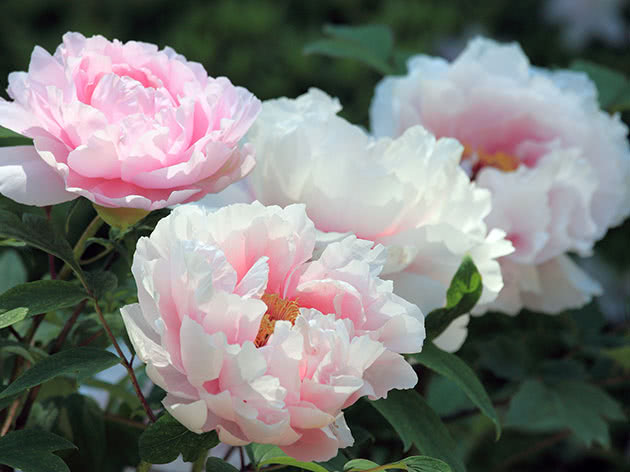
Care of peonies in spring
Peonies require an infrequent, but abundant watering – 2-3 buckets of water per adult bush to soak the soil to the depth of the roots. Especially plants need moisture during growth period in early spring, during budding and flowering and in August-September when peonies form new buds. After watering it is necessary to loosen the soil around the bushes and remove the weeds, if any. Make sure that when watering the water gets under the bush, and not over the leaves.

Fertilizing of peonies
As soon as the snow melts, the soil around the bushes is watered with a solution of potassium permanganate at a rate of 0.07-0.1 oz per 2.2 gallons of water for two peony bushes. When the shoots begin to grow, it is necessary to fertilize the plants with ammonium nitrate at a rate of 0.5 oz of potassium nitrate per 2.2 gallons of water. Beginning from the second week of May, young plants are watered with a solution of mineral fertilizer in the recommended concentration from a watering can with a sieve once a month over the leaves. Add some detergent in the solution at a rate of 1 tablespoon per 2.2 gallons of water – this will prevent the solution from simply flowing down the leaves into the soil. Top dressing is done in the evening or on a cloudy day. During the period of budding and flowering it is necessary to carry out the mineralization of soil with such a solution: 0.35 oz of superphosphate, 0.26 oz of ammonium nitrate, 0.17 oz of potassium salt per 2.2 gallons of water. Two weeks after the end of flowering, it is necessary to feed peonies with a solution of 0.35 oz of superphosphate and 0.17 oz of potassium salt per 2.2 gallons of water. You can alternate mineral fertilizers with organic fertilizers, and instead of using solution you can scatter dry fertilizers along the furrow around the bush, followed by moistening and embedding into the soil.
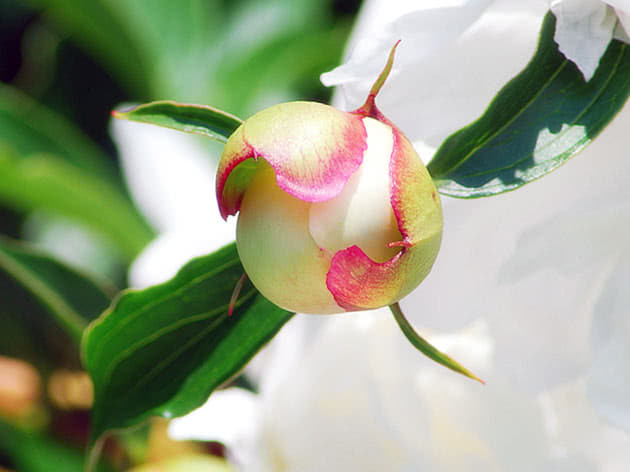
Care of peonies in summer after the peonies have faded implies timely watering, fertilizing after flowering, weeding and loosening the planting site.
Pruning of peonies
When to prune peonies? A full pruning of peony stems is carried out in late autumn, when frosts begin. But if you need to do this earlier, you should cut the stems not too low, leaving the shoots with three or four leaves above the ground. The fact is that at the end of summer peonies form the flower buds, and the success of this process directly depends on the presence of the leaves on the bush. Therefore, by the way, when cutting flowers, you should observe this rule: cut the flower stem not very closely to the root, leave a part of the stem with several leaves on the bush.
Peony transplanting
When to replant peonies
Wild peonies grow in one place up to fifty years and more. Hybrid varieties that originate from common peony can grow for not more than ten years in one place without being transplanted. When this period is over, the bush needs to be divided and replanted to another place. In addition, the division and planting out of the bush are the simplest and most reliable way to propagate peonies. But for this purpose you should use 4-5 year old shrubs that fully bloomed once or twice. The fact is that the root system of peonies heavily spreads out over the years, so it is easier to cope with a younger rhizome than with the old one, so it will be better to divide and replant bushes every three to four years for the quality of blooming not to decrease. Peonies are transplanted in September.
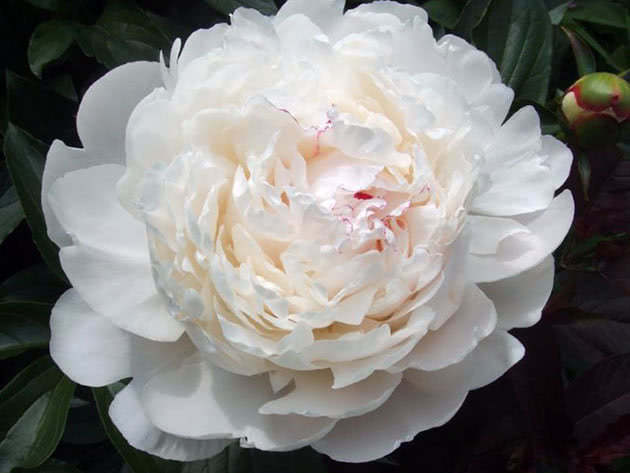
Transplanting of peonies in autumn
How to transplant peonies? In autumn, the bush is dug up at a distance of 10 inches from the rhizome, then gently shaken with forks and carefully removed from the ground. The rhizome is cleaned from the remains of soil with a peg, then it is washed with a slow stream of water not to damage the fragile vegetative buds of peonies. The ground part is cut almost to the root. The washed rhizome is left in the fresh air for water to drain and for the roots to get slightly withered and more elastic. Then, the old thick roots are cut to a length of 4-6 inches at an angle of 45 °. Carefully inspect the root and only then proceed with division. If the bush is old, the most convenient way is to drive a hammer into its center to split the rhizome into several parts. Often in the middle of old rhizomes there are voids and decayed areas that need to be cleaned, disinfected with a strong solution of potassium permanganate, and then the sections are powdered with a fungicide. The cuttings should consist of root neck parts with 3-4 well developed vegetative buds and several roots. It is necessary to try to divide the rhizome into approximately equal parts, so that there will be neither too large cuttings that may be ill a long time after transplanting, nor too small cuttings that may die.
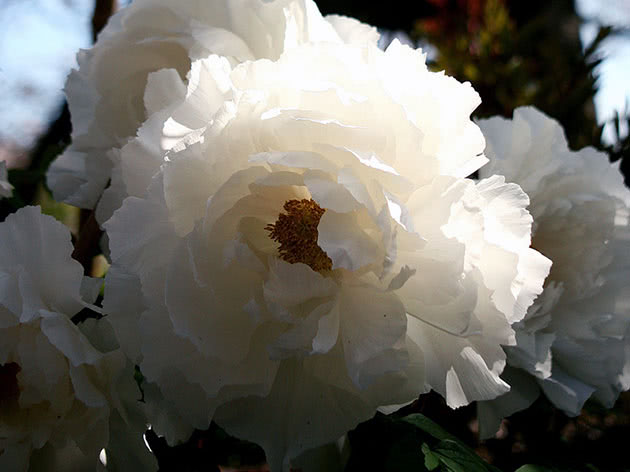
How to transplant peonies
The cuttings should be planted in the ground in the way that has already been described. The site with transplanted plants must be covered with a 2.7 inch layer of peat in winter, you can remove the mulch when reddish sprouts of peonies get through it in spring. During the first two years after transplanting, the peonies should increase the root system, so be patient and do not let young plants bloom. In the first year, remove all the buds that appear, the next year you can leave only one bud on the bush and, when it starts opening, cut it out as low as possible and take a good look at how the flower corresponds to its variety. If the correspondence is incomplete, then you will have to remove the buds one more year leaving only one bud, until the flower will fully correspond to its own variety. This can happen in the third or even the fifth year.
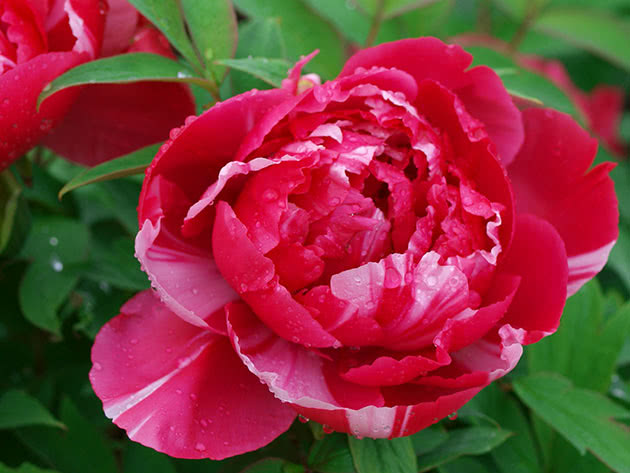
Propagation of peonies
Reproduction of pions by seeds
You already know about the vegetative way of peony propagation by the method of bush dividing. Peonies are also propagated by other ways, for example, by seeds. But it should be noted that the seeds of peonies do not always retain varietal qualities, therefore they are used only by breeders as a rule. Besides, the plants grown from seeds start blooming only in the fourth to fifth year. But if you want to breed a new variety, then sow freshly harvested seeds in August directly into loose soil, and next spring they will germinate.
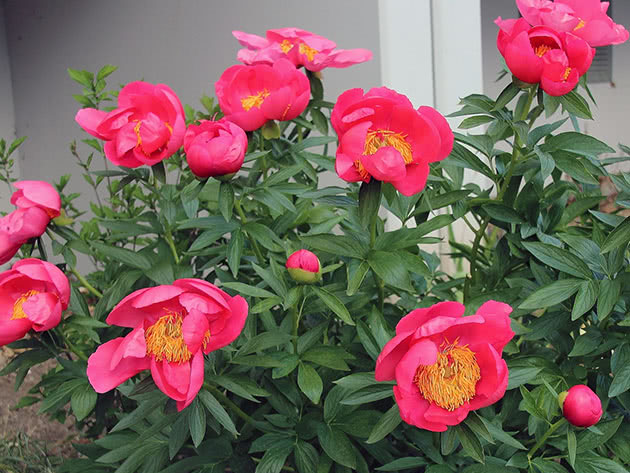
Propagation of peonies by root cuttings
This is the most reliable method of peony propagation. A small part of the rhizome with a dormant bud is separated from the bush in July, planted, and by September it will have already taken root. However, this method is not convenient for those who are in hurry: such shoots develop slowly and start blooming for the first time in five years.
Peonies after flowering
Peonies faded – what to do?
Peonies fade in early-mid-June. Remove all spent flowers, in two weeks carry out a third top dressing with phosphorus and potassium fertilizers and keep on watering the plants regularly. In August, watering should become more abundant, as this is the period of forming the flower buds and the plant will need moisture.
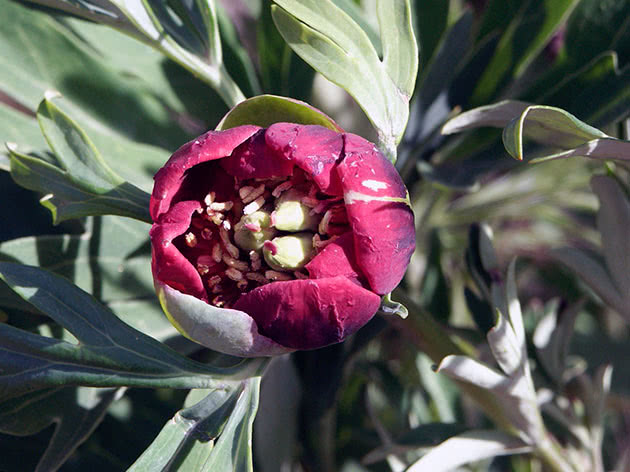
Preparation of peonies for winter
When the leaves and stems of peonies begin turning yellow, watering should be gradually reduced, and when the frosts come, you need to cut out the ground part of the bush almost to the level of the soil. If in autumn you plant out old peonies or plant new ones, you will have to cover this area with a 2-2.7 inch layer of peat mulch so that in winter the weak peonies will feel comfortable after transplanting. In spring, when there are shoots of peonies, a layer of mulch can be removed.
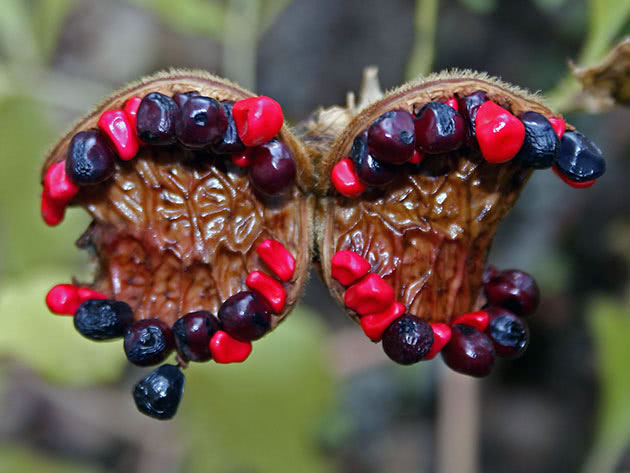
Peonies in winter
Peonies overwinter in the garden. Old bushes are not afraid of frosts, and if you cover the young peonies for the winter, then you can be calm: your flowers will not die.
Diseases and pests of peonies
Among all existing diseases, peonies mainly suffer from gray mold – botrytis. This disease is manifested in the middle of May by decay of stems, although buds and leaves can also get infected by botrytis – the parts of the plant are covered with gray mold. The excess nitrogen, tightness on the flowerbed and rainy weather contributes to the development of this disease. Infected areas should be cut off and burned away from all plants. As a preventive measure, you can spray the plant with a solution of copper sulfate (1.8 oz per 2.2 gallons of water) or garlic water (0.35 oz of pressed garlic per 35 fl.oz of water). You should sprinkle both a plant and soil around the bush.

Sometimes peonies can get infected with powdery mildew – a fungal disease that affects the leaves of peonies and covers them with a white coating. To fight with powdery mildew you should spray the plant with a soap solution (7 oz g of laundry soap, 0.7 oz of copper sulfate per 2.2 gallons of water).
Species and varieties of peonies
According to the structure of the flower, peonies are divided into 7 groups:
– simple peonies that have one or two rows of petals. Flowers are large, in the center of the flower there are numerous stamens, the leaves are sometimes wavy (for example, Golden Glow, Nadia);
– semi-double peonies have very large light flowers, the stamens are located either in the center of the flower, or between the petals. A flower usually consists of seven rows of petals. The varieties are Miss America ( it is a medium-early variety, pink flower of 10 inches in diameter becomes white after the opening, the stamens are bright yellow); Ann Berry Cousins (it is an early variety of coral-pink color, a cup-shaped flower is 6.7 inches in diameter, a bush is up to 2.1 ft in height);

– Japanese peonies have modified stamens in the center of the flower that form a pompom, there is either one or two rows of petals. The varieties are Carrara (it is a mid-season variety of white color and 6.3 inches in diameter, the height of the bush is 2.6 ft); Hot Chocolate (it is a mid-early peony of maroon color, 6.3 inches in diameter, the height is up to 2.6 ft);
– anemone peonies are a transitional form of Japanese peonies to a group of double peonies. The lower petals are wide, rounded, arranged in two rows; the central petals are shorter and form a sphere. The varieties are Rhapsody ( it is a medium-early variety, marginal petals are pink, central petal are yellow-cream and form a sphere, diameter of the flower is 6.3 inches, height of the bush is 2.3 ft); Snow Mountain (it is an early-season peony of creamy color and 6.7 inches in diameter, the height is 2.5 ft);
– double hemispherical, bomb-shaped, globular peonies have petals collected in a hemisphere, when fully opened the petals form a sphere. The varieties are Pink Cameo ( it is a medium-late variety of cream-pink color of 6.3 inches diameter, the bush is 2.6 ft in height); Monsieur Jules Elie ( it is an early fragrant variety of lilac-pink color, the diameter is 8 inches, the height is 2.9 ft);

– rose-shaped peonies have the petals that are very similar to a rose in structure, they are the same in size, round, wide, large. The varieties are Solange (it is a late-season cream-white peony, 6.7 inches in diameter, the height of heavy stems that need support reaches 2.3 ft); Henry Bockstoce ( it is an early-season variety of bright red color, 6.3 inches in diameter, the bush is 2.9 ft high). In the group of rose-shaped peonies there is a sub-group of semi-rose shaped peonies that differ by the presence of the spot of stamens in the middle of the flower. The varieties are Goody ( it is a medium-early, bright crimson variety, 6.3 inches in diameter, the height is 2.3 ft); Ballerina ( it is an early white-cream-green variety, the bush is powerful, the diameter of the flowers is 7 inches);
– crown hemispherical and globular peonies – лепестки цветков расположены в три яруса: верхний ярус – кольцо лепестков, средний состоит из более узких, чем на верхнем и нижнем ярусе, лепестков. Как правило, верхний и нижний ряды одного цвета, средний ряд по цвету может отличаться. Сорта: Нэнси – ранний сорт розово-персикового цвета 17 см в диаметре, куст до 80см высотой. Аритина Нозен Глории – очень ранний сорт розово-сиреневого оттенка, высота куста – 70 см, диаметр цветка – 20 см.
